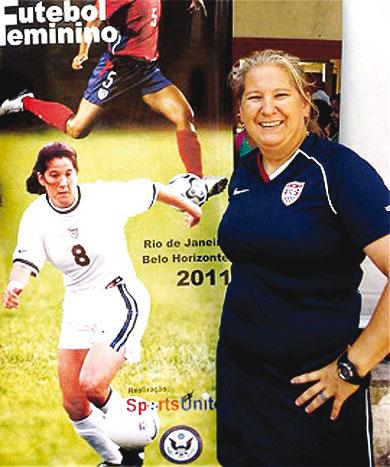US Soccer’s Centennial Remembers….

By Ray Alley
It’s a mystery that the name Linda Hamilton isn’t often mentioned when the discussion turns to the all-time outstanding U.S. Women’s National Team players.
This Georgia native (Atlanta) played 71 times for the U.S. WNT over nine years. She played in the first two FIFA Women’s World Cups.
Perhaps best described as a “warrior”, Hamilton was a lock-down defender, a “hard” player who competed hard. She was a starter for the U.S. when the team won the very first World Championship in China in 1991, and there again in Sweden four years later for a third-place finish.
“She was a hammer. She liked to take players out,” said Anson Dorrance, who added Hamilton to the U.S. WNT in 1987. Dorrance spoke to Scott French for a “Where Are They” article for USSoccer.com.
“She was very physical, very combative. Sort of an in-your-face defender with tremendous physical courage and with a wonderful capacity to intimidate.”
At the collegiate level, Hamilton played against Dorrance for three years while leading the N.C. State Wolfpack. After[show_disconnected][show_to accesslevel=’Subscriber’] her junior season, she transferred to Chapel Hill and helped the Tar Heels to a national championship as a senior. She earned All-America honors all four years.
Hamilton is one of a surprisingly small number of former U.S. WNT players who have continued to be involved in the game as a collegiate head coach. She finished her 5th season last fall as head coach of the University of North Florida Ospreys.
She has remained involved with U.S. Soccer, serving on the Board of Directors of the USSF, U.S. Soccer Foundations and U.S. Athletes Council. She realizes she was a “different kind of player.”
“I don’t know if there’s been a player like me since me,” she was quoted in the U.S. Soccer article. “I’m not saying it makes it better or worse, but there’s been times we sure could have used someone like me.”
She helped anchor a back line with Megan McCarthy and then Joy Fawcett (Biefeld). Carla Overbeck orchestrated the defense as the sweeper.
Overbeck’s job was to clean up any breakdowns, which were limited by Hamilton’s aggressive defense.
“I could count on her to defend her player very well,” Overbeck was quoted as saying. “She was fast and she was physically and mentally tough. She didn’t back down from challenges. You always knew she was going to get the job done.”
Hamilton was a key performer on a team of legends on that first World Cup championship team that beat Norway, 2-1 in the final.
That team included forwards Michelle Akers, Carin Jennings (now Gabarra) and April Heinrichs, midfielders Mia Hamm, Kristine Lilly, Julie Foudy and Shannon Higgins (now Cirovski), and with Mary Harvey in goal.
“I have heard it said by Anson so many times, I would have to say I was a blunt instrument. And I played with reckless abandon,” Hamilton said.
“We played a very grueling system of man-marking all over the field, so I had to be athletic and strong and fit and fast. My role on the team was sort of an enforcer-type of defender.”
Dorrance agreed, “She was so naturally combative, she took that role like a duck to water.”
She played on through the 1995 World Cup, where she started six games for head coach Tony DiCicco, who had replaced Dorrance as national coach.
Norway upset the U.S. in the semifinals, and the Americans settled for third place.
By 1995 her knees were in bad shape. Seven surgeries, including two for torn ACLs, had taken their physical toil, but did not touch her competitive drive.
“I could see myself slowing down,” said Hamilton. “I was getting beat with things that didn’t beat me before.
“All I know is that every time I stepped on the field with those players around me, every time we lost a game, I was not only angry, but shocked. There was not ever a time in any game no matter what the score was that I thought we were going to lose.”
Hamilton enjoys coaching and she enjoys recruiting, saying “it’s fun to find that diamond in the rough, so to speak.”
North Florida is competitive in the Atlantic Sun Conference, but Hamilton continues to seek that signature win over one of the elite Division I programs. That breakthrough victory would push the Ospreys to another level.
“The biggest challenge is trying to get the breakthrough win, a win against a big team,” she said, “and getting talented players to consider your school.”
She has to be creative in the way she recruits and allocates scholarship funds. North Florida is working toward getting fully funded (scholarship level). The breakthrough victory would go a long way in making that closer to happening.
[/show_to][hide_from accesslevel=’Subscriber’]
Your subscription has expired please
Subscribe to Southern Soccer Scene to view full article and get all the news in your mailbox![/hide_from]
